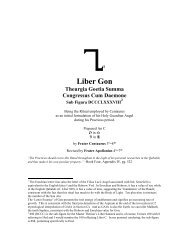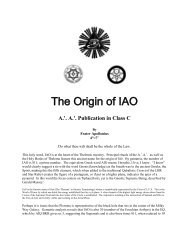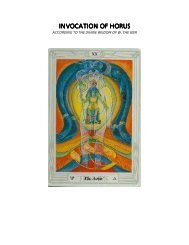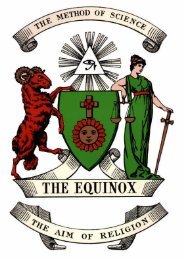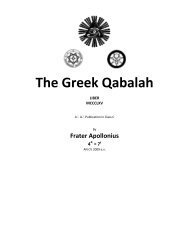ATAT The World-Ash Wonder Tree - Astron Argon
ATAT The World-Ash Wonder Tree - Astron Argon
ATAT The World-Ash Wonder Tree - Astron Argon
You also want an ePaper? Increase the reach of your titles
YUMPU automatically turns print PDFs into web optimized ePapers that Google loves.
y<br />
Frater Apollonius<br />
4°=7 □<br />
<strong>ATAT</strong><br />
<strong>The</strong> <strong>World</strong>-<strong>Ash</strong> <strong>Wonder</strong> <strong>Tree</strong><br />
My adepts stand upright; their head above the heavens, their feet below the hells.<br />
—Liber XC:40
Do what thou wilt shall be the whole of the Law.<br />
<strong>The</strong> „axis mundi‟ is a geographic and mathematical symbol used by Hermeticists to represent the<br />
center of the world where the heavens connect with the earth; „as above, so below‟. It is<br />
represented in the Gnostic Mass by the Rod that the Priest holds. Yet it also represents an<br />
anatomical trinity representing the birthing process. As a feminine symbol, it is represented by<br />
the umbilical chord that connects the child to the womb; as a masculine symbol, it is represented<br />
by the phallus and as a unisex symbol, it represented by the navel—the sacred omphalos.<br />
As the <strong>Tree</strong>-of-Life is presented as the connecting link between humanity and that which we call<br />
divine, the „<strong>World</strong> <strong>Tree</strong>‟ is represented in several religions and mythological systems as the tree<br />
that supports the heavens and is yet rooted in the Earth. This of course includes the „underworld‟<br />
that for us today, is the Astral Plane. <strong>The</strong> <strong>Tree</strong>-of-Life then, is an archetypal map of our Astral<br />
Bodies. As an evolving symbol, it has had its own ontological development in Western culture.<br />
<strong>The</strong> tree reaches from the underworld to the sensory and material world, on into the starry sky.<br />
It is this same tree represented in the Book of Revelation:<br />
22:1 And he showed me a river of water of life, bright as crystal, proceeding out of the throne of God and of the<br />
Lamb, 22:2 in the midst of the street thereof. And on this side of the river and on that was the tree of life,<br />
bearing twelve manner of fruits, yielding its fruit every month: and the leaves of the tree were for the healing<br />
of the nations.<br />
It is not a far cry from „<strong>World</strong>-<strong>Ash</strong> <strong>Tree</strong>‟ to the „<strong>Tree</strong>-of-Life‟; the completion of the journey that<br />
started with the „<strong>Tree</strong>-of-Knowledge (of Good & Evil).‟ Indeed, the symbol in Revelation comes<br />
at the end of the biblical story as the <strong>Tree</strong>-of-Knowledge was at the start in Genesis. And as an<br />
evolving symbol, these two trees have had their own ontological development in Western<br />
culture. <strong>The</strong> <strong>Tree</strong>-of-Knowledge finds its placement on the <strong>Tree</strong>-of-Life in Da‟ath (Knowledge)<br />
where PAN is Guardian; PAN being the ALL and with the Abyss being the conversion from the<br />
ONE to the ALL. We are also told in Liber AL vel Legis that Nuit‟s hair is “the trees of<br />
eternity;” and even that such saps and/or gums that come from these things are her incense.<br />
AL I.59: “My incense is of resinous woods & gums; and there is no blood therein: because of my hair the trees of<br />
Eternity.”<br />
This paradigm is yet remembered of various cultures; for example, the story of Yggdrasil (a huge<br />
ash tree) of the Hungarian region of Europe is still told and as well, those in today‟s spiritual<br />
community know of the Sacred Oak of Nordic mythology. Yggdrasil is generally translated as<br />
„Odin‟s Horse‟ 1 . In the more secular, we use the symbol of the tree to denote social, professional<br />
and familial networks. Crowley‟s Liber CXXIV, which lays out some recommendations for the<br />
O.T.O. as a community, and is subtitled: Of Eden and the Sacred Oak: and of the Greater and<br />
Lesser Hospitality of the O.T.O.<br />
1 <strong>The</strong> horse is also a vehicle, both independent of and attached to the Chariot of the Merkabah Tradition.
From the East, there is the Hindu <strong>Ash</strong>vastha, or fig tree, which interestingly enough includes the<br />
root „ash‟ in its name. And for us, has an interesting connection to the praeter-human<br />
correspondence of Runar Karlsen; the DOzmt Index, which as a symbol of the <strong>Tree</strong>-of-Life.<br />
A ancient shamanic seeress in Nordic prophecy called the „Volva‟ (with an interesting phonetic<br />
relation to the female anatomy; vulva) remembers in this prophecy called the „Edda‟, being<br />
reared by „Jotnar‟ or giants with an obvious connection to the story in Pseudpegripha of the<br />
Nephilim. <strong>The</strong> „Nine <strong>World</strong>s‟ of the Yggdrasil would seemingly be equivalent to the nine<br />
Sefirot on the <strong>Tree</strong>-of-Life.<br />
Yggdrasil is presented in two books in the prophetic work, the „Prose Edda‟ as „chief or holiest<br />
place of the gods‟ and „the biggest and best of all trees, that its branches extend out over all of<br />
the world and reach out over the sky‟. It has three main roots that reach deep into manifestation;<br />
one reaching out over the demonic Aesir, who war with the more angelic Vanir. A second root<br />
reaches over the „Frost Jötnar‟ or the Jotun; decribed aptly in Wikipedia with a very obvious<br />
connection with the legend of the Nephilim:<br />
A Jötunn [ˈjøːtun], Old Norse jǫtunn /'jɔtunː/, anglicized Jotunn or Jotun, pronounced /ˈjoʊtən/, /ˈjoʊtʊn/, or /ˈjɔːtʊn/, [1][2] is a<br />
giant in Norse mythology, a member of a race of nature spirits with superhuman strength, described as sometimes standing in<br />
opposition to the races of the tribes of the Æsir and Vanir, although they frequently mingle with or intermarry with these. <strong>The</strong>ir<br />
otherworldly homeland is Jötunheimr, one of the nine worlds of Norse cosmology, separated from Midgard, the world of humans,<br />
by high mountains or dense forests. Other place names are also associated with them, including Niflheimr, Utgarðr and Járnviðr.<br />
In some legends and myths they are described as having the same height as humans.<br />
That these Jotnar live in the astral world of the „Nine‟, is notably consistent with the<br />
pseudpegriphic idea of the Nephilim being trapped in the lower astral. Cf. Reign of the<br />
Demiurge. And with the third root going over Niflheim, the world of mist that we might call the<br />
Aethyr and is etymologically consistent with the English word for „dark.‟ 2 This shows an<br />
interesting parallel with the N.O.X. and the physical world of „Dark Matter.‟ Cf. Testing the<br />
Night of Pan. And indeed, this third root is also said to extend into heaven, which would be of<br />
the Aethyr and from its most dense and invisible origin; that of Dark Matter or the N.O.X.<br />
An eagle or hawk, reminiscent for us as Horus, is said to sit on the branches of the Yggdrasil,<br />
sending „malicious messages‟ by way of a squirrel named Ratatoskr (the traveler) to the<br />
Niohoggr; a dragon that gnaws at the roots of the tree. This clearly shows the path to the divine<br />
as leading away from the cycle of the dragon as depicted in the Starry Gnosis and all<br />
reincarnation cycles as the constellation Draco.<br />
<strong>The</strong> <strong>Ash</strong> <strong>Tree</strong> in the mountains of Greece exude a sugary substance called „Méli‟ or honey and<br />
most interestingly, „Soma‟ and „Manna.‟ In the Gnostic Mass, this sap (of the “world-ash,<br />
wonder tree”) symbolizes the crystallization of light in the blood. Until the early part of the<br />
twentieth century ev, this sap was harvested and sold under the name "manna". "It exudes<br />
spontaneously or by incisions during the hottest and driest weather in July and August.”<br />
2 <strong>The</strong> similarity to the word ‘Nephilim’ is apparent.
In the nineteenth century this product was important as a pharmaceutical, and early editions of<br />
<strong>The</strong> Dispensatory of the United States of America devote substantial space to it:<br />
MANNA... a concrete saccharine exudation of Fraxinus ornus and of Fraxinus rotundifolia... Besides the two species<br />
of Fraxinus indicated by the Pharmacopoeias, it is said to be obtained from several other trees belonging to the genera<br />
Ornus 3 and Fraxinus among which F. excelsior and F. parvaflora have been particularly designated...It exudes<br />
spontaneously or by incisions during the hottest and driest weather in July and August...It is owing to the presence of<br />
true sugar and dextrin that manna is capable of fermenting...Manna, when long kept, acquires a deeper color, softens,<br />
and ultimately deliquesces into a liquid which on the addition of yeast, undergoes the vinous fermentation.<br />
In India, Soma is connected to the ASVATTHA tree, which is rooted in the highest heaven and<br />
descends through the spaces bearing all existing worlds on its branches. And in Sanskrit<br />
literature there is the assertion that honey rains down from the skies. Something very similar<br />
happens with the Jews; Manna fell from the skies as they wandered in the desert. Though<br />
references to Soma as a „divine intoxicant‟ indicate a connection to ash trees that only grow in<br />
the Himalayas. <strong>The</strong> twin horsemen Avins have a honey whip (madhurasa), which has been<br />
interpreted as lightning. Rig Veda 1.157 is a prayer to them: "Bedew our power with honey and<br />
with oil... sprinkle us with your whip that drops honey-dew."<br />
Macdonnell said:<br />
In both the Rig Veda and the Avesta it is stated that the stalks [of Soma] were pressed,<br />
that the juice was yellow and mixed with milk; in both it grows in the mountains, and its<br />
mythical home is heaven, whence it comes down to earth.<br />
...Soma is the branch of a ruddy tree (Rig Veda 10.94.3) . ...<strong>The</strong> Soma drops themselves<br />
are several times compared with rain (Rig Veda 9.41.3, 9.89.1, 9.106.9) and Soma is said<br />
to flow clearly with a stream of honey like the rain-charged cloud (Rig Veda 9.2.9). ...<strong>The</strong><br />
belief in an intoxicating beverage the home of which is heaven, may be Indo-European. If<br />
so, it must have been regarded as a kind of honey mead (Skt. mádhu, Gk. methu, As.<br />
medu) brought down to earth from its guardian demon by an eagle (the Soma-bringing<br />
eagle of Indra agreeing with the nectar-bringing eagle of Zeus and with the eagle which,<br />
as a metamorphosis of Odhinn, carried off the mead).<br />
A huge volume of research has been published about Soma. A large recent bibliography appears<br />
in Haoma and Harmaline by D.S. Flattery and M. Schwartz. <strong>The</strong>y argue that the Iranians in their<br />
haoma used a species of Ephedra, the American species of which are sometimes called Mormon<br />
Tea. No summary of the state of the debate is possible, but it appears that no one has considered<br />
the possibility that soma is the memory of a honey mead beverage based on fermentable "honey"<br />
obtained from plants. <strong>Ash</strong> tree manna, as the Dispensatory of the United States of America noted,<br />
is fermentable, and ash trees do grow in India, including Fraxinus excelsior (the species familiar<br />
to the Germanic peoples), but only in the Himalayas above the elevation of 1300 m.<br />
3 <strong>The</strong> similarity of this word to the modern (so-called) Alchemical substance called ORMUS is apparent.
In Norse mythology, the description of Yggdrasil (the world ash) explain the sugary property of<br />
ash trees. It rained honey on the world, and mead flowed in its branches. <strong>The</strong> first man, Ask<br />
(<strong>Ash</strong>), was formed from an ash tree found on the beach by Odin and his brothers, sons of BOR.<br />
Odin is called Yggjung - old-young. Ygg is eternal, awesome or old as in ageless. Yggdrasil is<br />
Odin's steed. After Ragnarok, mankind will be restored from a man and woman sheltered within<br />
the world ash and nourished on dew. <strong>The</strong> Greek goat Amalthea parallels the goat Heidrun of<br />
Norse mythology, which bites stalks off the world ash tree and yields mead from its udders for<br />
the enjoyment of those feasting in Valhalla.<br />
<strong>Ash</strong> trees have a prominence in Greek mythology. Hesychius writes: melías karpós: tò<br />
anthrópon génos. ("Seed of ash: the race of men"). When Ouranos was overthrown by Kronos,<br />
Giants, Furies, and nymphs called Meliai were formed. Meliai means ash trees; the Meliai are<br />
honey or bee nymphs. A single word described three different substances: honey made by bees,<br />
honeydew (produced by aphids and scale insects), and manna secreted by trees. <strong>The</strong> Giants are a<br />
certain reference to the Nephilim of the Pseudpegripha. In the biblical account "jealous" deities<br />
(Elohim) - when humans had eaten of the fruit of the tree of knowledge of good and evil - feared<br />
"lest he put forth his hand, and take also of the tree of life, and eat, and live forever."<br />
Greeks did note the consumption of manna and honeydew by their barbarian neighbors, and they<br />
called these substances meli. Aelian mentions honey from box trees in Pontus, honey from plants<br />
in Thrace, and rains of honey in the spring in India. Diodorus Siculus says Nabateans ate "plenty<br />
of honey from trees" and Herodotus mentions the town of Callatebus in Lydia, "where craftsmen<br />
make honey from wheat and tamarisks". Strabo tells of some extremely barbaric peoples on the<br />
eastern side of Pontus who put bowls of "crazing honey" (mainoménou mélitos) in the road,<br />
which they had made from tree twigs. Some of Pompey's troops drank the mixture, were driven<br />
out of their minds, and were easily slaughtered. In the Odyssey, Circe mixed a drugged beverage<br />
that turned men into swine (some things don't change.)<br />
This sap seems to have a similar effect as that of the; being transformative in nature. Note also,<br />
the ancients felt that honeydew spontaneously precipitated from the atmosphere, much in the<br />
same way as the normal dews of water are examined in <strong>The</strong> Golden Chain of Homer. In fact, the<br />
honeydew of the <strong>Ash</strong> <strong>Tree</strong> was associated with the same seasons as water dews.<br />
Aristotle says:<br />
<strong>The</strong> honey is what falls from the air, especially at the risings of the stars and when the rainbow descends. On the whole<br />
there is no honey before the [morning] rising of the Pleiad... Honey [the bee] does not make, it fetches what falls.<br />
Pliny the Elder speculates as to the source of this dew:<br />
Honey comes out of the air, and is chiefly formed at the risings of the stars, and especially when the dogstar itself<br />
shines forth, and not at all before the risings of the Pleiades, in the periods just before dawn. Consequently at that<br />
season at early dawn the leaves of trees are found bedewed with honey and any persons who have been out under the<br />
morning sky feel their clothes smeared with damp and their hair stuck together, whether this is the perspiration of the<br />
sky, or a sort of saliva of the stars, or the moisture of the air purging itself... Falling from so great a height, and
acquiring a great deal of dirt as it comes, and becoming stained with the vapor of the earth that it encounters, and<br />
moreover having been sipped from foliage and pastures and having been collected in the stomachs of bees - for they<br />
throw it up out of their mouths, and in addition being tainted by the juice of flowers, and soaked in the corruptions of<br />
the belly and so often transformed, nevertheless it brings with it the great pleasure of its heavenly nature.<br />
<strong>The</strong> honeydew of the <strong>Ash</strong> <strong>Tree</strong> is actually the excrement of aphids and scale insects, though still,<br />
this is from a modern work on bee-keeping:<br />
Honeydew... is often so abundant on the leaves of trees and bushes that it drops upon the grass and sidewalks, covering<br />
them with a glistening coating resembling varnish. At times it falls in minute globules like rain... <strong>The</strong> dew is forcibly<br />
ejected or flipped from the end of the abdomen, and when there are many aphids it falls in a spray of minute globules.<br />
If the dew were not thrown a little distance from their bodies they would soon be glued together... When freshly<br />
gathered it may be clear, sweet, and agreeable in flavor... <strong>The</strong> better grades find a sale to bakers.<br />
Some scholars have suggested that the world ash may really have been an oak. This may further<br />
explain the title of Crowley‟s O.T.O. document: Of Eden and the Sacred Oak: and of the Greater<br />
and Lesser Hospitality of the O.T.O.; connecting the Oak <strong>Tree</strong> with Eden and the Tress of Life &<br />
Knowledge. Another synonym for the „sap‟ of the <strong>Ash</strong> <strong>Tree</strong> is „Mead,‟ and the fermentation of<br />
mead was found unreliable, which has been said to possibly explain the origin of mixed<br />
beverages:<br />
This is an ideal medium for the growth of many undesirable microorganisms, which will multiply if not suppressed by<br />
yeast growth ( the opposite is true of most ripe fruits, including grapes, whose surface is covered with yeast cells.)<br />
Excellent mead can be made without the addition of spices and herbs, just as good meat is not in need of improvement.<br />
<strong>The</strong> strength, as well as the quantity, of many of the materials added in these old recipes - either before or after<br />
fermentation - strongly suggests an attempt to mask a poor or faulty product.<br />
Migratory peoples collected honey, honey-dew, and sweet tree resins (calling them all by the<br />
same name), fermenting them and adding aromatic herbs and often enough, hallucinogenic<br />
ingredients. This ritual, which connects trees, tree resins, and honey, is also found amongst the<br />
Indo-Europeans, and was indeed a mead tree; raining celestial honey on the world. <strong>The</strong> secretion<br />
of fermentable honey by the <strong>World</strong> <strong>Ash</strong> <strong>Wonder</strong> <strong>Tree</strong> was said by Indo-Europeans to be the<br />
nurse of gods and men. This honey in its raw form, direct from the tree provided the food of the<br />
gods. <strong>The</strong>refore, the <strong>World</strong> <strong>Ash</strong> <strong>Wonder</strong> <strong>Tree</strong> physically linked gods and men; becoming the<br />
connecting link.<br />
Love is the law, love under will.
Bibliography<br />
A history of the English parish: the culture of religion from<br />
Augustine to Victoria<br />
By Norman John Greville Pounds<br />
<strong>The</strong> <strong>Ash</strong> <strong>Tree</strong> In Indo-European Culture<br />
Mankind Quarterly, Volume XXXII, Number 4, Summer 1992, pp. 323-336.<br />
Odin's Ordeal<br />
Nine days on Yggdrasil<br />
By Pip Wilson<br />
http://www.wilsonsalmanac.com/odins_ordeal.html<br />
Wikipedia<br />
http://en.wikipedia.org/wiki/File:Yggdrasil.jpg<br />
http://en.wikipedia.org/wiki/<strong>World</strong>_tree<br />
http://en.wikipedia.org/wiki/Yggdrasil<br />
Axis Mundi<br />
http://www.newworldencyclopedia.org/entry/Axis_Mundi<br />
Notes from Diane's Garden Or <strong>The</strong> Curious Lore and Magical<br />
Property of Plants<br />
By Diane Fenster<br />
http://www.compostcoven.org/cnl/dianelam89ash.html<br />
<strong>The</strong> Western Wisdom Teachings<br />
Supplementary Philosophy Course<br />
Lesson No. 30<br />
http://members.fortunecity.com/rosanista/library02/spceng30.htm<br />
http://www.musaios.com/ash.htm




